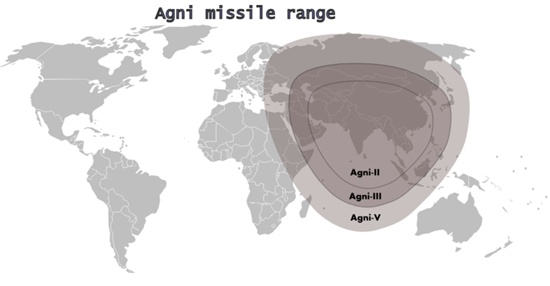DRDO to test Agni-V ICBM in next three months
17 Nov 2011
New Delhi: A day after the successful test of the new-generation, 3,500-km Agni-IV missile, senior defence scientists said Wednesday that the near-ICBM Agni-V, with a strike range of 5,000-km, would be tested sometime in the December-February period.
"The three-stage Agni-V is undergoing integration at the moment...it's on schedule," DRDO chief Dr VK Saraswat said, adding that both Agni-IV and V were comparable to the best missiles in their class as far as the technology was concerned.
According to Agni programme director, Avinash Chander, the Agni-V would certainly be ready for induction into the armed forces by 2014, while the two-stage, Agni-IV would become operational by 2013 after two to four more "repeatable" tests.
"Our aim is to take just two to three years from the first test to the induction phase," he said.
The 20-tonne Agni-IV and 50-tonne Agni-V are expected to add the required muscle to India's nuclear deterrence posture against China, which has a huge nuclear and missile arsenal like the 11,200-km Dong Feng-31A ICBM capable of hitting any Indian city.
The Agni-IV and V are expected to provide India the required operational flexibility against China as they are endowed with greater accuracy, fast-reaction capability and road mobility.
Both the missiles will be capable of striking high-value targets deep inside China.
The Agni-V is a three stage solid fuel missile with composite motor casing in the third stage. Two stages of this missile will be made of composite material. Advanced technologies like ring laser gyroscope and accelerometer will also be used in the new missile, allof which were tesed with the Agni-IV.
The Agni-5 is specially tailored for road-mobility, according to Avinash Chander.
The DRDO is successfully developed the canister for these missiles and all India's future land-based strategic missiles will be canisterised.
Made of maraging steel, a canister must provide a hermitically sealed atmosphere that preserves the missile for years. During firing, the canister must absorb enormous stresses when a thrust of 300 to 400 tonnes is generated to eject the 50-tonne missile.
The Agni-V will, in future, feature Multiple Independent Re-entry Vehicles (MIRVs) with each missile being capable of carrying 3-10 separate nuclear warheads. Each warhead can be assigned to a different target, separated by hundreds of kilometres; alternatively, two or more warheads can be assigned to one target.

MIRVs ensure a credible second strike capability even with few missiles.
According to Dr Saraswat the "indigenous content" in India's strategic missiles had gone up to such a level that "no technology control regime" could derail the programme any longer.
The current focus, according to Dr Saraswat, was on fine-tuning the Agni missile systems to enable them to defeat anti-ballistic missile systems.
Towards this end, radar and other "signatures" of Agni-IV had been significantly reduced to make them "much more immune to counter-measures".
The DRDO is also working on MIRV (multiple independently targetable re-entry vehicles) warheads, which can be programmed to hit different targets.













.jpg)






.jpg)









